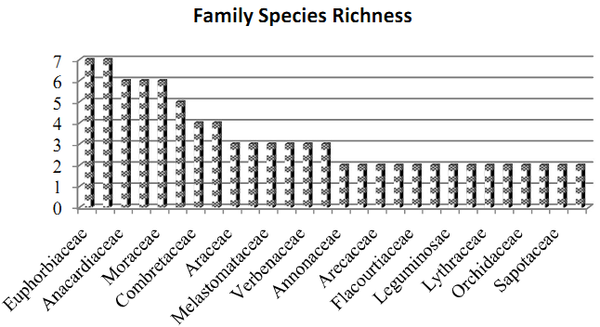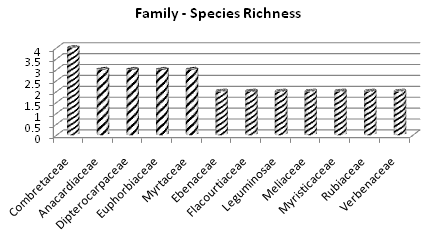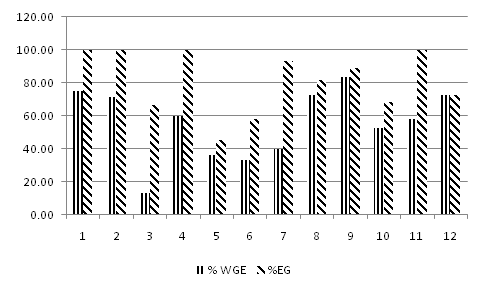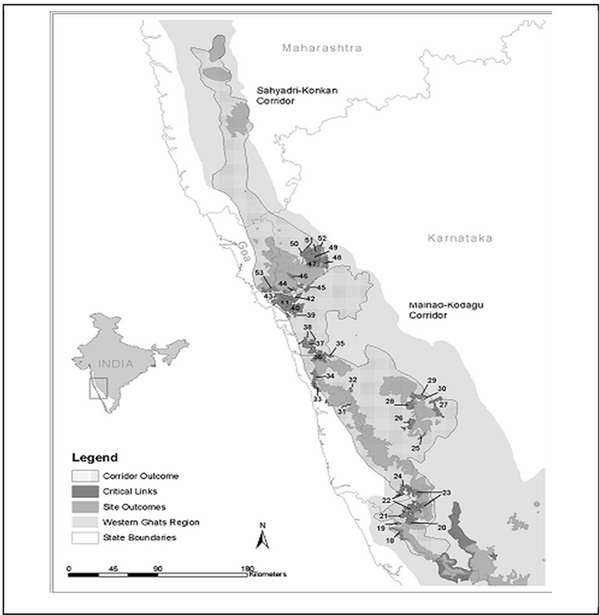| Sahyadri Conservation Series: 24 |
ENVIS Technical Report: 54, April 2013 |
 |
Kumaradhara River Basin, Karnataka Western Ghats: Need for Conservation and Sustainable Use |
 |
1Energy and Wetlands Research Group, Centre for Ecological Sciences, Indian Institute of Science, Bangalore – 560012, India.
2Member, Western Ghats Task Force, Government of Karnataka, 3Member, Karnataka Biodiversity Board, Government of Karnataka
4Member, Tree Authority Mangalore (Rural), Government of Karnataka
*Corresponding author: cestvr@ces.iisc.ac.in
|
IMPACT SCENARIO FROM MHS IN KUMARADHARA RIVER OF DAKSHINA KANNADA
Kukke Hydro Projects Pvt. Ltd. (KHPPL) has purposed a power project to generate 24 MW Hydroelectric power utilizing naturally available potential energy in the water flows of Kumaradhara River near Kunthuru -Perabe village in Dakshina Kannada district of Karnataka, and supply the same to Karnataka Power Transmission Corporation Limited (KPTCL). The Kukke hydroelectric project claims as a run-off the river scheme across the river Kumaradhara. This project, it is feared, is in the pipeline for hasty execution with scant regard for the rich but fragile environment, that through generations have sustained farmers while safeguarding also reasonable amounts of biodiversity organized into various ecosystems in the basins of Kumaradhara River and Gundia River. Ecological significance of the region is evident from:
- Critical links of the Malnadu-Kodagu Corridor: In fact Gundia joins Kumaradhara at Koodige Ulippu at Hosmatta in Puttur taluk, the wedge shaped stretch of forests from the point of their confluence to distances beyond constituting the Kunturu Estension Reserve Forest that is exceptionally rich in species. This extension forest is one of the critical links of the Malnadu-Kodagu Corridor identified and recommended for protection by the CEPF (2007). The Kunturu/Panaja range reserve forests parts of which will be submerged by the project houses some of the most rare and endangered flora of India.
- River of rare fishes: The Western Ghats are home to over 218 fresh water fishes, of which 116 are endemic to the region (Daniels, 2001). A study identified 56 different fish species from Kumaradhara River (especially in its constituent Gundia) out of which 23 are endemics, 11 are Vulnerable and 8 are Endangered as per IUCN Red List of threatened species (http://wgbis.ces.iisc.ac.in/biodiversity/pubs/ces_tr/TR122/section2.htm). Daniels (2001) had dealt with adverse impact of dams on the distribution of many fish species. Fish like Horabagrus brachysoma – Gunther’s catfish (Vulnerable) and Etroplus canarensis (Endangered) are among the fishes of Kumaradhara.
- Presence of rare swamps: The region is home to endangered Myristica swamps, of which few survive to this day. Swamp specific and Critically Endangered Syzigium travancoricum and Gymnacranthera canarica (Vulnerable) are amongst many other species. The swamp ecosystem of Western Ghats is highly threatened one.
- Extinction threat to Madhuca insignis: Kumaradhara River banks are the last habitat of IUCN Red listed evergreen tree Madhuca insignis, which was declared extinct and rediscovered in this region after 125 years. The tree, in the whole world, confined to the river bank and on raised mounds in the river bed is considered Critically Endangered. The submergence of the riparian forest patches under the mini-hydel projects proposed in the river is strongly feared to bring an uncertain future for this rare tree.
- Threat to Ochreinauclea missionis: Riparian forest submersion in the focal area is bound to disrupt the scanty population of this endemic and Vulnerable Rubiaceae tree confined to the banks of Kumaradhara and rivers further south. The tree is considered a monotypic genus and is attributed with medicinal properties.
- Threats to other endemic plant community: The riparian plant community with high degree of endemism is bound to collapse with the submergence and other disturbances. A list of endemic species is given in Table 7.
- New reports from the riverbasin: Apart from the only known population of Madhuca insignis, a surprising rediscovery of a lost species after 120 years, the river basin has ferns like Helminthostachys zeylanicus and Schizaea digitata, both very rare and first time reports for Karnataka.
- Medicinal plants and NTFP species: Area has large number of medicinal plants and non-timber forest product (NTFP) yielding plants. Every year lakhs of rupee worth Myristica malabarica aril is collected from the riparian forest.
- Forests in support of farming: Leaf manure is a vital necessity for farming activities in the interior of Dakshina Kannada, constituting the foothills of the Western Ghats, where seasonal rains are extremely heavy (4000-6000 mm/year) posing threats of serious levels of soil erosion and nutrient depletion unless the ground is littered with a thick layer of leaf manure. The farmlands in high density along the low lands by the river sides, producing crores of rupees worth spices, arecanut, coconut, banana etc. are interspersed with patches of secondary woods which the locals depend on for collection of leaf manure. Even if the gardens are spared by the mini-hydel projects, agriculture or gardening will not prosper if the river bank forests get submerged.
Significant Findings:
The study region harbors species rich forests, despite the fact most forests, particularly in Puttur and Sullya areas are highly fragmented due to Rubber and Areca plantations. Owing to high rainfall, in many places evergreen forests rich in endemic and some threatened species occurred in many places. The vegetation of the area can be divided broadly into the following types:
- Tropical wet evergreen to semi-evergreen rain forests: These were mostly found in areas with minimum disturbances. The emergent trees in these forests are over 30 m tall and covered with innumerable climbers and epiphytes. Notable of these are Vateria indica, Bischofia javanica, Calophyllum tomentosum, Elaeocarpus tuberculatus, Diospyros spp., Holigarna spp., Hopea parviflora, Mangifera indica, Lophopetalum wightianum, Syzygium spp., Polyalthia fragrans and rarely Mesua ferrea etc. These emergent trees are followed by canopy species of 20-25 m in height. Species in this stratum include Canarium strictum, Cinnamomum macrocarpum, C. sulphuratum, Dimocarpus longan, Fahrenhetia zeylanica, Garcinia gummi-gutta, G. morella, Litsea spp., Myristica dactyloides, M. malabarica, etc. Still beneath are trees of lesser stature such as Mallotus tetracoccus, Nothopegia racemosa, Vepris bilocularis etc. The evergreen forests are rich in palms like Arenga wigthii and Caryota urens in addition to the straggler palm Calamus spp. (canes). In association with these evergreen climax forests, in isolated pockets occur endangered Myristica swamps is of high importance. These are fresh water swamps dominated by members of the family Myristicaceae. Gymnacranthera canarica, a member of this family is exclusively found in such swamps whereas the presence of Critically Endangered tree species of Syzygium travancoricum (Krishnakumar et al., 2006) further highlights the high conservation values of this habitat.
- The riparian vegetation: Riparian vegetation bordering the Kumaradhara and Gundia rivers, threatened with wholesale submersion on execution of the hydel pojects, are something unique, being the only known place in the world for Madhuca insignis, an evergreen tree and a riverside counterpart of the Indian butter tree or mahua tree, Madhuca indica. The tree grows alongside the river including in small raised portions within its sandy floodzones, along with trees like Ochreinauclea missionis, Carallia brachiata, Euonymus indica, Vateria indica, Calophyllum apetalum, Eleocarpus tuberculatus, Hopea ponga etc. The submersion of this vegetation on account of damming will not only eliminate this irreplaceable tree species but also lead to collapse of these sand mounts and rest of river banks, which are presently safeguarded by many other habitat-specific plants like Cyperus pangorie, Ochlandra scriptoria, etc. Submersion will also affect several other habitat specific marsh herbs like Cryptocoryne retrospiralis, Dichanthium huegeli and Rotula aquatic and the shrubby Homonea retusa and a rare fern Osmunda regalis along the stream flow.
- Tropical moist deciduous forests: The secondary forests of the region, owing their origin to human alterations of primary forests are characterized by trees such as Careya arborea, Mallotus philippensis, Celtis sp., Aporosa lindleyana, Dillenia pentagyna, Lagerstroemia microcarpa, Terminalia paniculata etc.
- Scrub jungles: Many hilltops and forests close to some of the human habitations are scrub jungles with occasional tree species such as Phyllanthus emblica, Careya arborea, Terminalia bellirica, etc. These scrubs often occur above the submersion levels.
- Grasslands and savannas: Highhilltops have grasslands with scattered shrubs of Wendlandia thyrusoide,Vanguria spinosa,Canthium parviflorus, etc. Small stunted trees have orchids such as Trias stocksii, species of Oberonia, Dendrobium, Eria, Porpax etc. Only the low level grasslands and savannas within 85 m altitude range are threatened with submersion.
- Scattered trees along plantations and abandoned fields: Large areas of land are under this type with many native lopped evergreen species standing scattered along the Rubber plantations and abandoned areas. Many of these wooded areas threatened with submersion hold vegetation that support the rich spice gardens in Kumaradhara-Gundia valleys, through supply of necessary leaf manure.
Vegetation analysis: Altogether 118 species of plants belonging to 55 families were recorded in the study (including transects and opportunistic sampling), which include trees, shrubs woody climbers etc. Among the plant families, Rubiaceae and Euphorbiaceae had the highest number of species with 7 species each followed by Moraceae, Ebenaceae and Anacardiaceae with 6 species each and Fabaceae with 5 species. All the remaining families were represented by less than 5 species each (Figures 9.1 and 9.2). A total of 47 tree species from 29 families were recorded from the transect based survey. The families Dipterocarpaceae, Myristicaceae and Lauraceae are some of the dominant primitive plant families of the region, also having many rare and endemic species. Species such Vateria indica, Hopea parviflora of Dipterocarpaceae had lofty trees while Lauraceae generally composed of smaller trees such Actinodaphne hookeri, Cinnamomum spp., etc. Rubiaceae and Euphorbiaceae consisted mostly of sub-canopy species of trees. Large numbers of woody lianas were seen such as Calycopteris floribunda, Derris spp., Gnetum ula, Combretum sp., Entada pursaetha etc.

Figure 9.1: Family-species richness in the study area (all including oppurtunistic survey)

Figure 9.2: Family-species richness in transect based survey

Note: %wg = percentage of trees endemic to the Western Ghats, %evg= percentage of evergreen trees in the tree community
Figure 10: Percentage evergreeness (%EG) and endemism(%EGE) in different transects
A hotspot of plant endemism: A list of higher plant species endemic to the Western Ghats threatened with submersion and/or fragmentation of habitats in case of execution of the Minihydel project is given in the Table 7.
Table 7: A list of endemic plant species of Western Ghats from pilot study of Kumaradhara submersion zone
| Sn |
Endemic plant species |
Family |
IUCN status |
| 1 |
Ervatamia heyneana |
Apocynaceae |
|
| 2 |
Cryptocoryne retrospiralis |
Araceae |
|
| 3 |
Lagenandra ovata |
Araceae |
|
| 4 |
Holigarna arnottiana |
Anacardiaceae |
|
| 5 |
Holigarna ferruginea |
Anacardiaceae |
|
| 6 |
Nothopegia racemosa |
Anacardiaceae |
|
| 7 |
Impatiens kleini |
Balsaminaceae |
|
| 10 |
Calophyllum apetalum |
Clusiaceae |
|
| 11 |
Garcinia gummi-gutta |
Clusiaceae |
|
| 12 |
Garcinia indica |
Clusiaceae |
|
| 13 |
Hopea parviflora |
Dipterocarpaceae |
Endangered |
| 14 |
Hopea ponga |
Dipterocarpaceae |
Endangered |
| 15 |
Vateria indica |
Dipterocarpaceae |
Endangered |
| 16 |
Diospyros angustifolium |
Ebenaceae |
|
| 17 |
Diospyros assimilis |
Ebenaceae |
|
| 18 |
Diospyro ccndolleana |
Ebenaceae |
|
| 19 |
Diospyros sylvatica |
Ebenaceae |
|
| 20 |
Trewia polycarpa |
Euphorbiaceae |
|
| 21 |
Dalbergia sympathetica |
Fabaceae |
|
| 22 |
Kingiodendron pinnatum |
Fabaceae |
Critically Endangered |
| 23 |
Moullava spicata |
Fabaceae |
|
| 24 |
Hydnocarpus pentandra |
Flacourtiaceae |
|
| 25 |
Flacourtia montana |
Flacourtiaceae |
|
| 26 |
Actinodaphne malabarica |
Lauraceae |
|
| 27 |
Cinnamomum sulphuratum |
Lauraceae |
|
| 28 |
Lagerstroemia microcarpa |
Lythraceae |
|
| 29 |
Memecylon angustiolium |
Melastomaceae |
|
| 30 |
Memecylon talbotianum |
Melastomaceae |
|
| 31 |
Aglaia canarensis |
Meliaceae |
|
| 32 |
Aglaia lawii |
Meliaceae |
|
| 33 |
Artocarpus hirsutus |
Moraceae |
|
| 34 |
Gymnacranthera canarica |
Myristicaceae |
|
| 35 |
Knema attenuata |
Myristicaceae |
|
| 36 |
Myristica malabarica |
Myristicaceae |
|
| 37 |
Syzygium travancoricum |
Myrtaceae |
Critically Endangered |
| 38 |
Chionanthus mala-elengi |
Oleaceae |
|
| 39 |
Cliestoma tenuifolia |
Orchidaceae |
|
| 40 |
Ixora brachiata |
Rubiaceae |
|
| 41 |
Mussaenda laxa |
Rubiaceae |
|
| 42 |
Ixora polyantha |
Rubiaceae |
|
| 43 |
Ochreinauclea missionis |
Rubiaceae |
|
| 44 |
Psychotria dalzelli |
Rubiaceae |
|
| 45 |
Psychotria flavida |
Rubiaceae |
|
| 46 |
Madhuca insignis |
Sapotaceae |
Critically Endangered |
| 47 |
Pterospermum reticulatum |
Sterculiaceae |
|
Homogeneous relic vegetation: The riparian forests are dominated by less tree species, but the intact patches have high levels of Western Ghat endemism. Diversity is not high in the riverine and riverbed vegetation, as compared to normal forests, in view of the flood tolerance that the vegetation has to overcome. At the same time presence of high tree endemism (of Western Ghats) (Table 8) indicates that this special kind of vegetation evolved along the river banks is irreplaceable. The high evergreenness, endemism and biomass of trees speak about the uniqueness. Species such as Madhuca insignis, Ochreinauclea missionis, Carallia brachiata, Vateria indica, Calophyllum apetalum, Sygygium heyneanum, Hopea ponga, Vitex leucoxylon, Diospyros embyopteres, Pongamia pinnata and Pandanus unipapilatus are normally found species.
Table 8: Percentage evergreen and tree endemism in 12 transects of riparian forests
| Transects |
Locations |
% evergreen trees |
% Western Ghat endemics |
| 1 |
Koodige-Gundia river |
100 |
75 |
| 2 |
-do- |
100 |
71 |
| 3 |
-do- |
67 |
13 |
| 4 |
-do- |
100 |
60 |
| 5 |
Kemmadakutir-Kunturu |
45 |
36 |
| 6 |
-do- |
58 |
33 |
| 7 |
-do- |
93 |
40 |
| 8 |
-do- |
82 |
73 |
| 9 |
Dolpadi |
89 |
83 |
| 10 |
-do- |
68 |
53 |
| 11 |
Palechar-Kuttruppady |
100 |
58 |
| 12 |
-do- |
73 |
73 |
Specialities of Kunturu Extension Reserve Forest: This reserve forest is present in a wedge of land between Kumradhara River on the southern side and Gundia River on the northern side. These two rivers join at 12°45’N lat and 75°23’E long. and from thereon flow as Kumaradhara. This extension forest is one of the critical links of theMalnadu-Kodagu Corridor (Figure 11) identified and recommended for protection by the CEPF (2007).

Figure 11: the Malnadu-Kodagu corridor (Source – CEPF, 2007)
|
|





